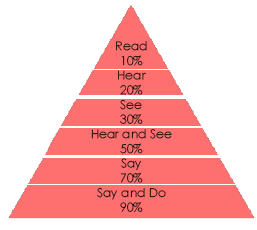Extensions
By encouraging parents to use many languages with their child, it reinforces their mother tongue and memory for language. This strengthens their family ties as well as their child’s brain. It is good family literacy practice to start with the family’s strengths, and encourage the family to continue helping their children learn by doing what they know and offering them other strategies to use when they want new strategies.
Multi-sensory learning helps people to learn things more easy. The more senses we use, the easier it is to remember things. Edgar Dale (1969) has a theory called the “Cone of Learning” which states that after 2 weeks, we remember

- 10% of what we read
- 20% of what we hear
- 30% of what we see
- 50% of what we hear and see
- 70% of what we say
- 90% of what we say and do
Children (and adults) who have a variety of multi-sensory experiences, increase their learning. By making experiences more multi-sensory, you are providing the opportunity for the families to eventually move toward abstract thinking and learning.
Literacy Activity
- Multi sensory grab and guess bags. Have parents dip their hands into a bag and try to identify, using non-visual cues, a mystery item from the kit by feel, smell, sound and have other parents predict what the item is. Encourage peer support and interaction.
Another activity – show them 10 items. Repeat the same order and hide the items. Have the parents then list the items. Now, provide them with 10 more items, let them hold each item as you name it. Now hide the items and have them list each item. Discuss which way they found easier to learn and remember the items.
Use a similar object for comparison for parents with low literacy skills. Or use paired objects for a similar guessing game